Designing kitchen furniture with your own hands: drawings of standard and corner cabinets with dimensions
A well-designed drawing of the kitchen – a guarantee of prompt and trouble-free assembly of furniture. A detailed design of a kitchen set with dimensions will help to avoid common mistakes during installation. The article contains practical advice of professional furniture makers, answers to frequent questions of newcomers, ready drawings of standard and corner kitchens, as well as a competently designed detail of the main types of cabinets.
Creating a project: where to start
Dimensions of the kitchen set are dictated by the dimensions of the premises, the nuances of the location of communications, doorways, windows, niches and ledges. Therefore, it is extremely important to make accurate measurements, indicating on the plan all the elements.
Measurements on the form:
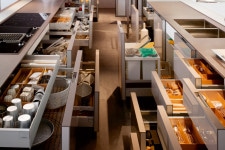
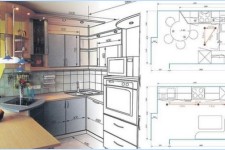
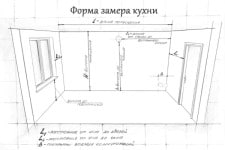

The scheme of a room by hand
When designing a kitchen design, it is necessary to take into account the size of household appliances, the standards of countertops, the acceptable dimensions of the lockers (height, width, depth).
Important!
- Information on the dimensions of the equipment is in the technical passport prepared by the manufacturer.
- Standard dimensions of the table top made of chipboard:
- height: 28 and 38 mm;
- length: 3050 and 4200 mm;
- depth: 600, 800, 1200 mm.
Standard size of kitchen cabinets
The height of the upper tier varies between 70-90 cm in increments of 5 cm.
The height of the lower tier of the kitchen: 850 or 900 mm. Depth of the lower cabinets: 500 mm – in this case the overhanging table top will be 4 cm in front (above the facades) and 6 cm from the rear.
The depth of the cabinets is 30 cm without the doors.
Standard width of kitchen cabinets: 300, 400, 500, 600, 800, 1000 mm. The standard for the net-cargo (bottle): 150, 200, 300 mm. The width of the cabinet for the hood: 600, 700, 900 mm.
The overall size of the lower corner cabinet is 800×800 or 900×900 mm.
Upper corner cabinet: 550х550 or 600х600 mm.

Location of standard lockers in a direct kitchen

Drawing of a standard set of furniture for a direct kitchen

Location of standard lockers in the corner kitchen

Drawing of a standard corner kitchen with horizontal hanging drawers
The principles of designing non-standard lockers
In case of impossibility of using standard sizes of kitchen cabinets, it is necessary to independently create a drawing of each cabinet separately taking into account the nuances of the room. Some options when you need non-standard furniture:
- Lugs or niches in the wall. In this case, the depth of the cabinet varies depending on the size of the wall deformation. That is, if the proposed furniture is a niche of 200 mm – the depth of the cabinet can be increased by 150-180 mm. If, on the contrary, there is a projection behind the back wall of the furniture, then the depth should be made smaller.
- The presence of communications, outlets. Here you need to make sure that there is free access to important communication nodes (joints, connections, ventilation grilles, valves, taps, etc.) and to the free use of the outlet for the intended purpose. To do this, a schematic image of the objects is first placed in the kitchen drawing, and during the design of each cabinet, they are drawn with a dotted line on the back wall. The dash is a variant of indicating the places for cut-outs during assembly and installation.
- Individual idea, complex furniture configurations, etc. In this variant, each piece of furniture is developed individually by a separate drawing. It is advisable to draw all complex connections close-up.

A ledge in the wall: an exemplary drawing of the lower kitchen cupboard

Drawing of a hinged box with recessed rear wall for gas pipe
Examples of kitchen sets with sizes
The construction and design of the kitchen always rests on the overall dimensions of the room. After all the strategic objects (pipes, sockets, ledges, etc.) have already been placed on the drawing, you can proceed to locate the cabinets for household appliances. Next, you should place standard furniture, and only then – non-standard designs.
Ready-made direct kitchen projects
Developing your own kitchen drawing, you can rely on ready-made kitchen designs with dimensions, while correlating the actual dimensions of the room with those specified in the sketch.
Standard kitchen set with dimensions:

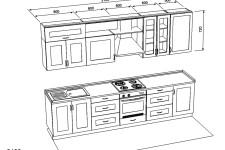
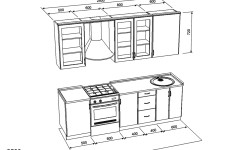
Drawing of a direct kitchen with non-standard cabinets:

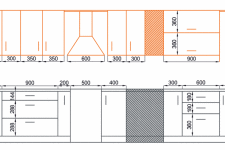
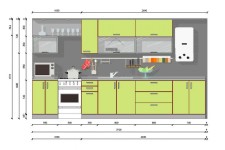
Variants of the drawings of corner sets
Drawing corner kitchen is recommended to start drawing from the lower corner cabinet. Further, they arrange furniture with household appliances, and then calculate non-standard pedestals.
Standard corner kitchen with dimensions:

Standard corner kitchen with dimensions
Designing a kitchen with a trapezoidal corner element:

Kitchen Design
Drawings of corner kitchen of non-standard size:
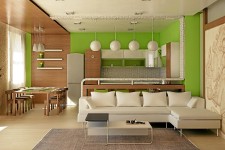
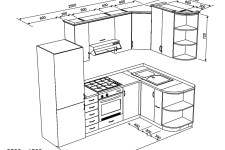

Detailing of the main kitchen cabinets: drawings and dimensions
Important!
- Calculation of the detail is made taking into account the thickness of the chipboard.
- The standard thickness of chipboard for the manufacture of kitchen furniture is 16 and 18 mm.
- Lower kitchen boxes are installed on adjustable supports 10 cm high.
- The support bar (lower base) is recommended to be made in one piece – unbreakable for the entire kitchen set.
- The following details and drawings of the kitchen are designed for chipboard 16 and a 28 mm countertop.
- The height of the lower tier is 850 mm, taking into account the countertop, the top – 720 mm.
Built-in oven cupboard

Drawing of a curbstone: 600х500
| the name of detail | Dimensions | amount |
| Side | 500×722 | 2 |
| Bottom | 500×568 | 1 |
| A shelf | 500×568 | 1 |
| Lower base | 100×600 | 1 |
Sink for washing
The width of the pedestal varies depending on the length of the sink.

Drawing of a kitchen cabinet for a sink 800 mm
| the name of detail | Dimensions | amount |
| Side | 500×722 | 2 |
| Bottom | 500×768 | 1 |
| The upper base (supporting the rod, the bar) | 80×768 | 2 |
| Lower base | 100×800 | 1 |
Locker with drawers
The width varies according to the size of the room or the wishes of the customer.
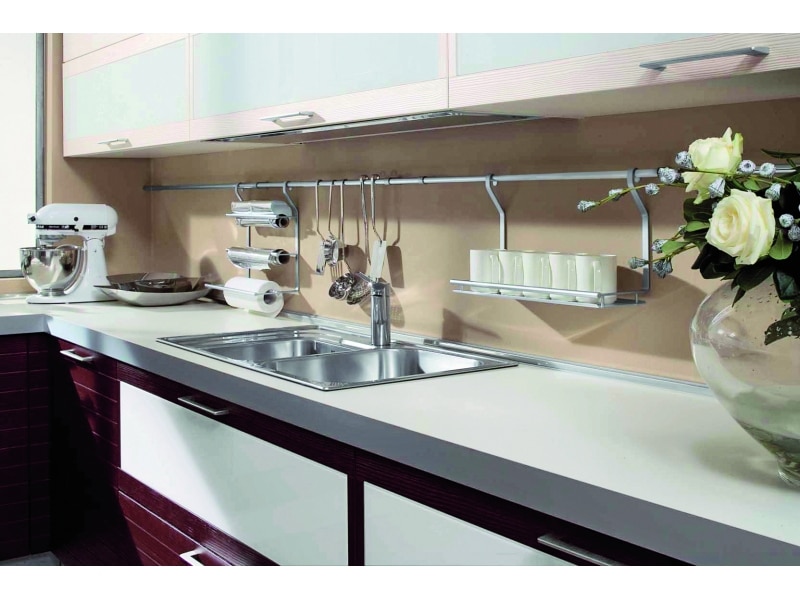
Sketch of a curbstone with 4 drawers, size 400×500
| the name of detail | Dimensions | amount |
| Side | 500×722 | 2 |
| Bottom | 500×368 | 1 |
| Side slats of the drawer | 140×500 | 16 |
| Lower base | 100×400 | 1 |
Lower cabinet with swinging facades
The size can be varied in width from 300 to 1000 mm.

Drawing of a kitchen cabinet with two doors, width 600
| the name of detail | Dimensions | amount |
| Side | 500×722 | 2 |
| Bottom | 500×568 | 1 |
| A shelf | 500×568 | 1-2 |
| Lower base | 100×600 | 1 |
Corner cabinet: two options
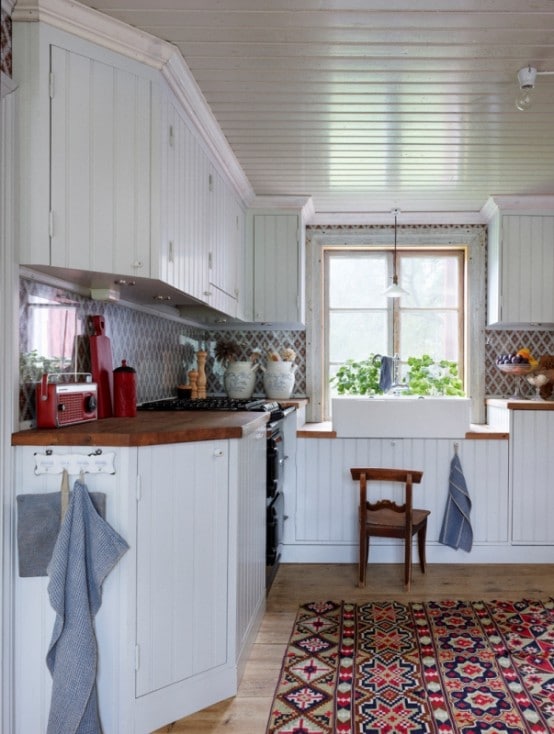
Sketch of L-shaped corner section 900х900
| the name of detail | Dimensions | amount |
| Side | 500×722 | 2 |
| The bottom, the roof (the curbstone under the sink is made without a roof) | 884х884c with a 90 за angle cut | 2 |
| Shelf (there is no shelf in the canteen under the corner sink) | 884х884c with a 90 за angle cut | 1 |
| Lower base | 100×420 | 2 |
| Vertical base | 100×806 | 2 |
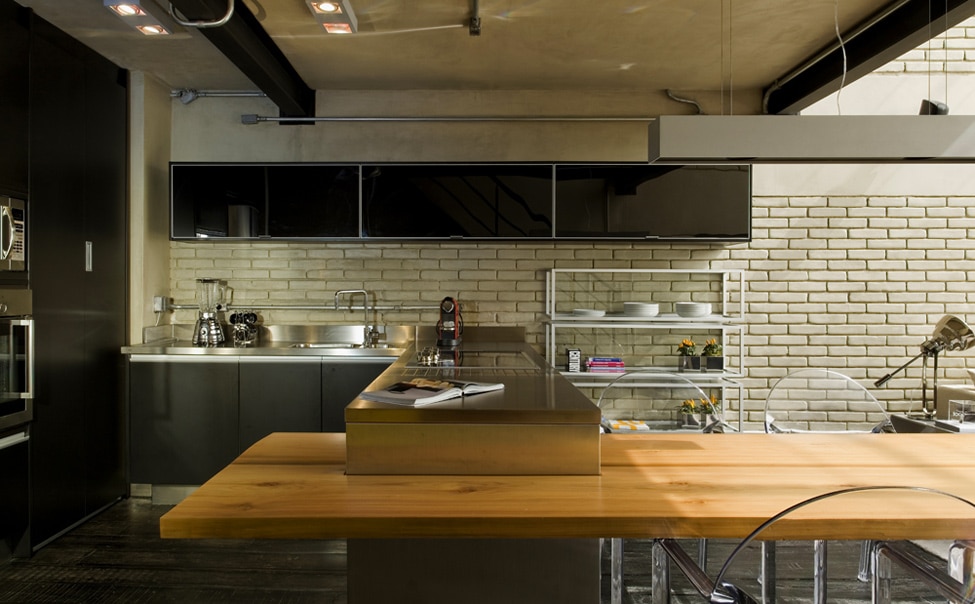
Drawing of the lower corner pedestal in the form of a trapezium 900×900
| the name of detail | Dimensions | amount |
| Side | 500×722 | 2 |
| The bottom, the roof (the curbstone under the sink is made without a roof) | 884×884 with a 45 за angle cut | 2 |
| Shelf (there is no shelf in the canteen under the corner sink) | 884×884 with a 45 за angle cut | 1 |
| Lower base | 100×600 (cut off “in place”) | 1 |
| Vertical base | 150×806 | 1 |
Cabinet for telescoping hood
The width of the cabinet varies depending on the width of the hood, the height is calculated in relation to the dimensions recommended by the manufacturer of household appliances.
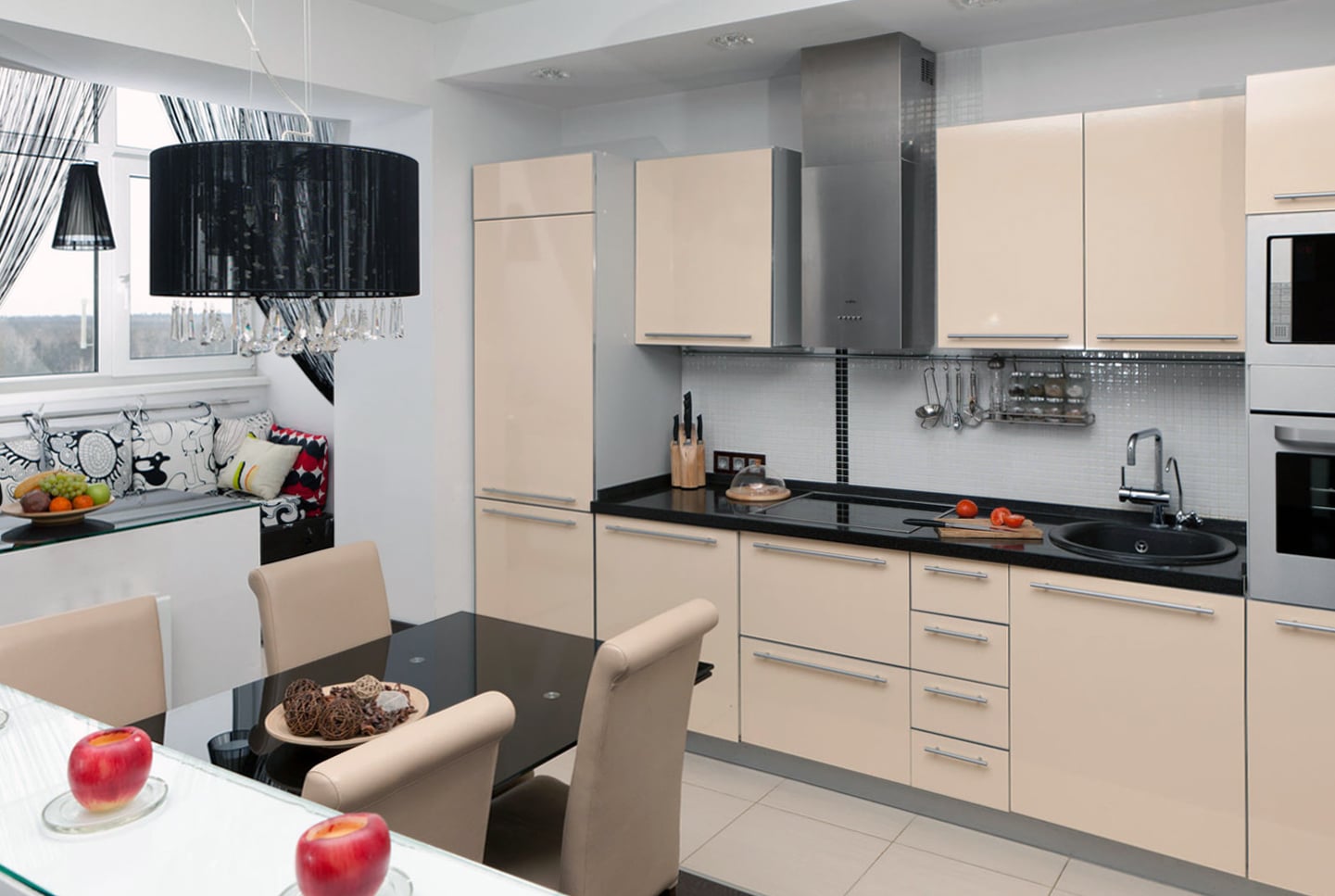
Project of a hanging kitchen cabinet for a standard telescopic hood 600 mm
| the name of detail | Dimensions | amount |
| Side | 300×720 | 2 |
| Roof | 300×568 (cut-out for corrugation) | 1 |
| A shelf | 300×568 (cut-out for corrugation) | 1 |
Hinged cabinet with swinging facades
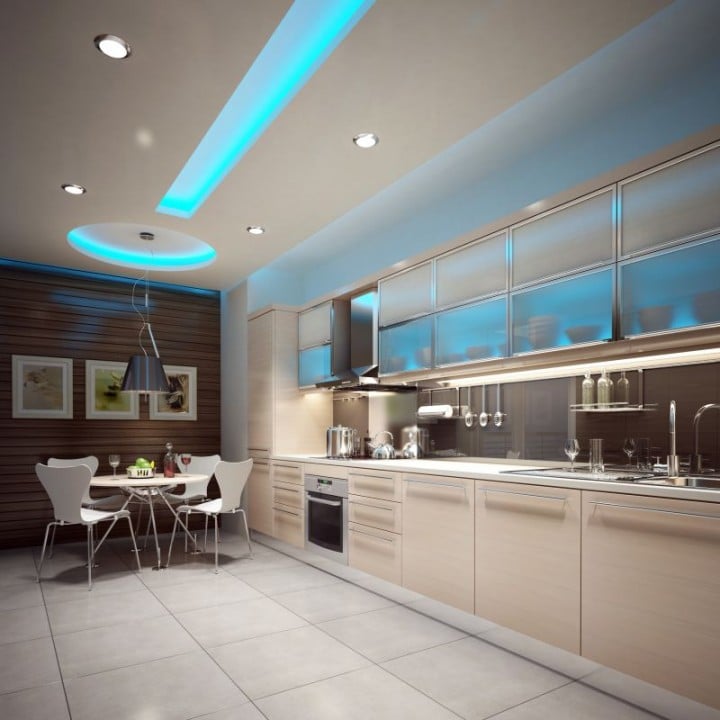
Drawing of the upper drawer with swinging facades 800×720
| the name of detail | Dimensions | amount |
| Side | 300×720 | 2 |
| Roof, bottom | 300×768 | 2 |
| Shelf (not in the cupboard with drying under the dishes) | 300×768 | 1-2 |
Curved corner cabinet: two options
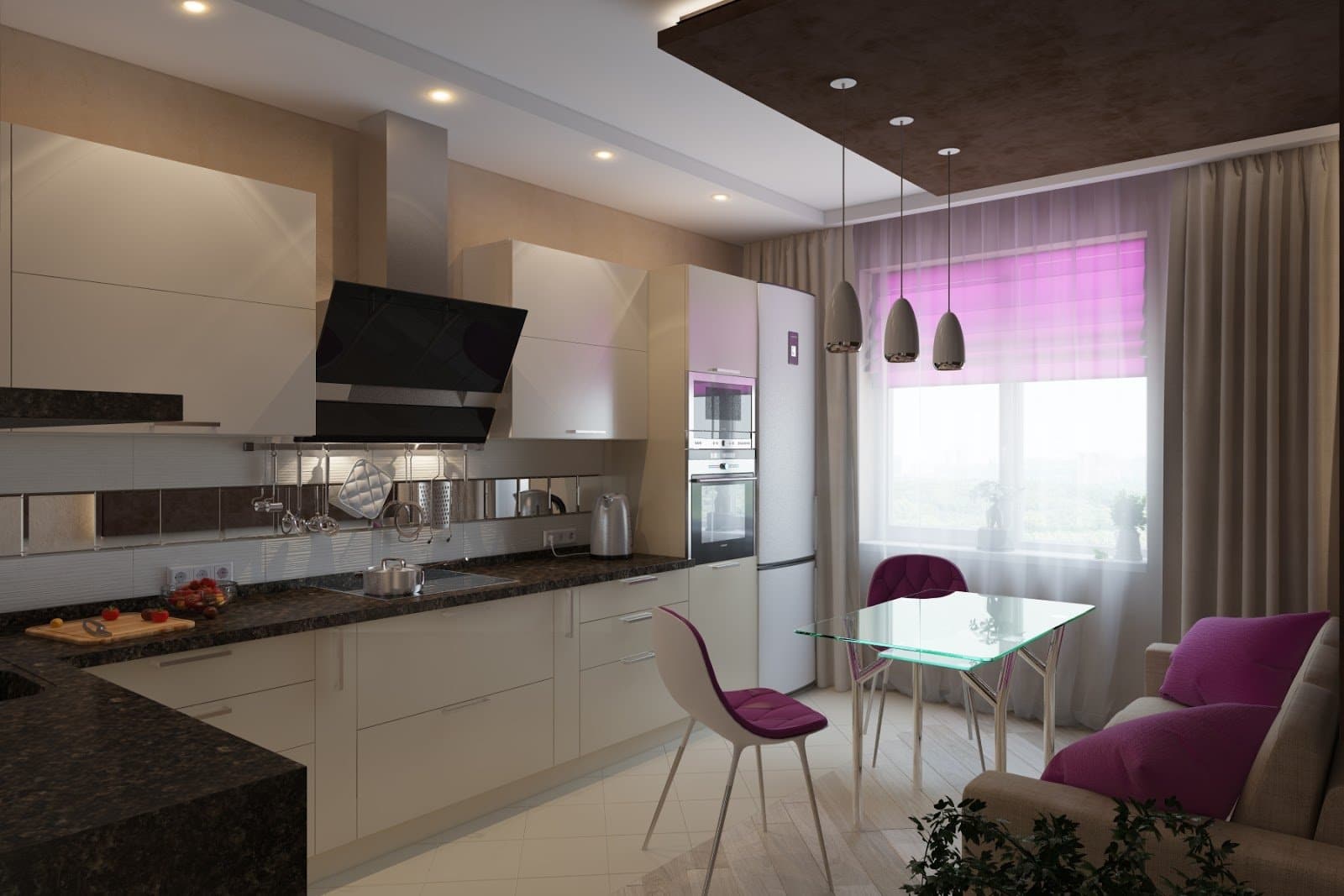
Drawing of a corner L-shaped cabinet 600х600
| the name of detail | Dimensions | amount |
| Side | 300×720 | 2 |
| Roof, bottom | 584×584 with a 90 за angle cut | 2 |
| A shelf | 584×584 with a 90 за angle cut | 1-2 |
| Tightening vertical base | 150 x 688 | 1 |
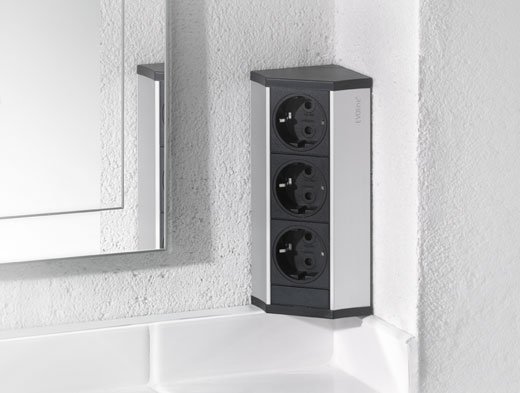
Sketch of a trapezoidal corner upper cabinet 600х600
| the name of detail | Dimensions | amount |
| Side | 300×720 | 2 |
| Roof, bottom | 584×584 with angle cutting 45⁰ | 2 |
| A shelf | 584×584 with angle cutting 45⁰ | 1-2 |
| Tightening vertical base | 150 x 688 | 1 |
FAQ: answers to common questions from beginners
- How to correctly measure the kitchen yourself?
Measure the room is necessary at different heights: at the floor level; in the area of the working surface (850 … 900 mm from the floor); at the level of human growth. This is necessary to reveal the unevenness of the wall. The height is also better measured at several points – to detect the curvature of the floor, ceiling.
Important! Horizontal measurements to objects in the kitchen (meters, pipes, windows, etc.), you need to do from one corner, taken for the base.
- What computer programs will suit a beginner for self-design of a kitchen drawing?
The most simple program for designing is PRO100. Intuitive and easy to understand: Astra Furniture Designer, bCad-furniture maker, KitchenDraw, WOODY, IKEA kitchen planner (excellent for standard furniture sets), AutoCad, 3D-constructor, Basis.
- Why do kitchenette drawings with dimensions always contain a gap in the area of the walls?
In the development of kitchens, especially corners, it is very difficult to foresee how perfectly the furniture fits into the given dimensions of the room. No one is immune from the blunder of the builders who left their uneven walls after their work. A small gap of 5-7 cm helps the furniture makers to install the set without serious alterations. If the furniture does not match the dimensions, the furniture can be moved within these limits, and after finishing the work, cover the remaining slit with a detail in the color of the facade.
- What is the distance between household appliances in the kitchen?
Between the technique is best to leave at least 500 … 600 mm.
- Is it possible to install a washing machine in the kitchen?
Oh sure. The main rule: the distance from the washing machine to the closest kitchen cabinets should not be less than 3 cm on each side.
- How many centimeters should be between the lower and upper tier of kitchen furniture?
The optimum distance is 60 cm. The exception is the cabinet for extracting – here it is necessary to rely on the recommendations prescribed in the technical passport of the device.
- In what order is it better to place household appliances on the kitchen drawing?
For right-handers the most acceptable option: a refrigerator, a sink, a stove. In this case, the mistress moves from left to right: she takes out food from the fridge, cleans and cleans them, then cuts (between the sink and the stove), and then – brews, fries, stew. For lefties it is better to use a mirror version of the location of household appliances: stove, sink, refrigerator.
- Why is it that the furniture on the legs is more durable than the one with the side parts of the case lowered directly to the floor?
Kitchen cupboards on adjustable legs can always be set at a level relative to the floor. In addition, when a variety of emergency situations occurred (the neighbors were flooded from above, the valve crashed, etc.) only the lower base is damaged, the replacement of which is less costly than updating the side parts of the cabinet.
- What should be made of the back wall of kitchen cabinets?
It is better to use fiberboard – and the reliability of the design is not adversely affected, and at a price more attractive.
- In what units should you specify the dimensions of the kitchen sets in the drawings?
Only in millimeters.
- Where should the sockets be located?
Schemes for placing electrical outlets in relation to household electrical appliances:
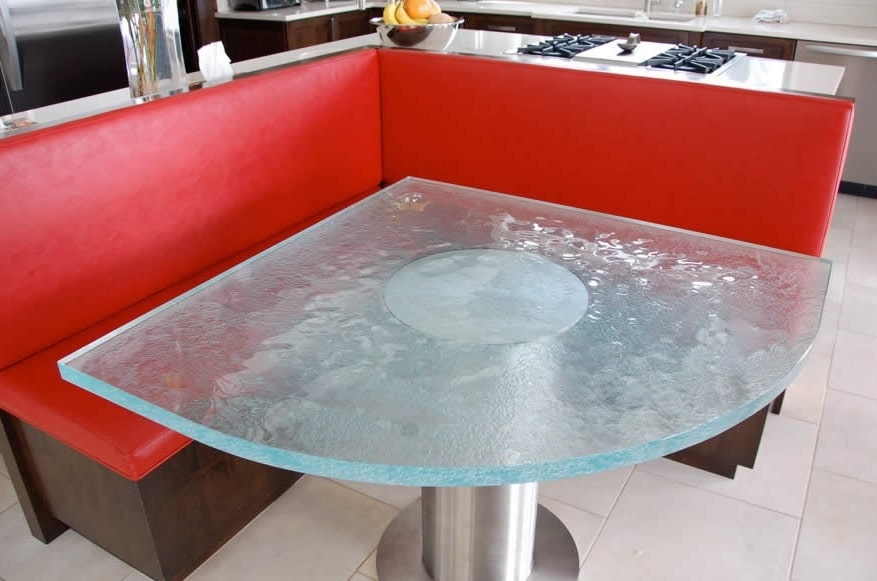
Layout of sockets

Recommended placements for sockets
- Is it possible to install in the corner kitchen a tabletop of 40-50 cm in depth at one of the walls?
No problem. The only condition is that in this part of the kitchen set there should not be built-in household appliances and a sink. All kitchen appliances have standard dimensions, calculated under the countertop of 60 centimeters.
- Standard kitchen drawings with sizes better or worse than design developments?
There is no unequivocal answer. For a typical kitchen, you can use a standard set of furniture, but for rooms with a redesign, you really need an individual calculation of the kitchen set.
Creating a drawing is a difficult and time-consuming process. But step-by-step planning, precise measurements, the correct placement of furniture and equipment, as well as strict adherence to the instructions and advice of professionals will certainly succeed. A linear sketch of a direct arrangement or a 3-D drawing of a corner kitchen with dimensions and details is the first step towards the kitchen set of your dream.


